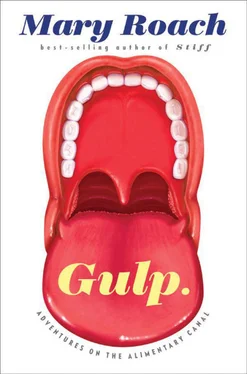Rodents, on the other hand, are slaves to sweetness. They have been known to die of malnutrition rather than step away from a sugar-water drip. In an obesity study from the 1970s, rats fed an all-you-can-eat “supermarket” diet that included marshmallows, milk chocolate, and chocolate-chip cookies gained 269 percent more weight than rats fed standard laboratory fare. There are strains of mice that will, over the course of a day, consume their own bodyweight in diet soda, and you do not want the job of changing their bedding.
Does that mean rodents feel pleasure in tasting sweet things the same way we do? Or is it simply a sequence of programmed responses, receptors sending signals and signals driving muscles? Video footage Danielle Reed sent me suggests that rodents do consciously perceive and savor the taste of something sweet. One clip shows a white mouse that has just been drinking sugar solution. She is shown in ultra-slow motion, filmed from below through a clear plastic floor, licking the fur around the sides of her mouth. (The caption uses the scientific term for lip-licking: “lateral tongue protrusion.”) Another clip shows a mouse that has just tasted denatonium benzoate, a bitter compound that parents used to paint on their children’s fingertips to discourage nail-biting. The mouse is doing everything it can to rid itself of traces of the chemical. It shakes its head and rubs its face with its hairy white forelegs. It pulls a “gape”: mouth opened wide, tongue stuck out to eject the offending food. (Humans do this too. The scientific term here is “the disgust face.”)
“If it’s exceedingly nasty,” Reed told me, “they will actually drag their tongue on the bedding to try to get it off.” Clearly taste matters to them.
Conversely, do animals with no taste buds derive no pleasure from eating? Is it just a daily chore? Has anyone observed—in, say, a python eating a rat—those same parts of the brain that light up when humans are experiencing taste delight? Reed doesn’t know. “But no doubt somewhere in the world there’s a scientist trying to get a live python into an fMRI machine.”
Rawson points out that although snakes can’t taste, they have a primitive sense of smell. They’ll extend their tongue to gather volatile molecules and then pull it back in and plug it into the vomeronasal organ at the roof of the mouth to get a reading. Snakes are keenly attuned to the aroma of favored prey—so much so that if you slip a rat’s face and hide, Hannibal Lecter–style, over the snout of a non-favored prey item, a python will try to swallow it. (University of Alabama snake digestion expert Stephen Secor did this some years back to reenact a scene for National Geographic television. “Worked like a charm,” he told me. “I can get a python to eat a beer bottle if I put a rat head on it.”)
For part of their development, human fetuses have a vomeronasal organ, though no one knows whether it’s functional. You can no more ask a fetus about these things than a python. Rawson surmises that the organ is a holdover from “when we were crawling out of the primordial soup, [13] Not a Campbell’s product.
and we needed to sense the chemicals in the environment and know which ones to go toward or away from.”
Rawson has an idea of what it is like to eat without perceiving tastes, because she has talked to cancer patients whose taste receptors have been destroyed by radiation treatments. The situation is well beyond unpleasant. “Your body is saying, ‘It’s not food, it’s cardboard,’ and it won’t let you swallow. No matter how much you tell your brain that you need to eat to survive, you’ll gag. These people can actually die of starvation.” Rawson knows a researcher who has been experimenting with using potent flavors—which, as we know from the last chapter, are mainly smells—to make up for absent tastes. Taste and smell are intertwined in ways we don’t consciously appreciate. Food technologists sometimes exploit the synergy between the two. By adding strawberry or vanilla—aromas we associate with sweetness—it’s possible to fool people into thinking a food is sweeter than it really is. Though sneaky, this is not necessarily bad, because it means the product can contain less added sugar.
Which takes us back to palatants, and why pet-food manufacturers love them. As one AFB employee put it, “The client can go, ‘Here’s my product. I want to cut corners here and here and here, and I want you to cover up all the sins.’” This is especially doable with dog food, as dogs rely more on smell than taste in making choices about what to eat and how vigorously. (Pat Moeller estimates that for dogs, the ratio for how much aroma matters to how much taste matters is 70/30. For cats, the ratio is more like 50/50.) The takeaway lesson is that if the palatant smells appealing, the dog will dive in with instant and obvious zeal, and the owner will assume the food is a hit. In reality it may have only smelled like a hit.
Interpreting animals’ eating behaviors is tricky. By way of example, one of the highest compliments a dog can pay its food is to vomit. When a “gulper,” to use Pat Moeller’s terminology, is excited by the aroma of a food, it will wolf down too much too fast. The stomach overfills, and the meal is reflexively sent back up to avoid any chance of a rupture. “No consumer likes that, but it’s the best indication that the dog just loved it.” Fortunately for the staff at the AFB Palatability Assessment Resource Center, there are other ways to gauge a pet food’s popularity.
“EVERYONE WANTS TO be Meow Mix.” Amy McCarthy, head of PARC, stands outside the plate-glass window of Tabby Room 2, where an unnamed client is facing off against Meow Mix, Friskies, and uncoated kibble in a preference test. If a client wants to be able to say that cats prefer its product over Meow Mix, they must prove it at a facility like PARC.
Two animal techs dressed in tan surgical scrubs stand facing each other. They hold shallow metal pans of kibble in various shades of brown, [14] Gone are the colored pet-food pieces of the early 1990s. “Because when it comes back up, then you have green and red dye all over your carpet,” says Rawson. “That was a huge duh .”
one in each hand. Around their ankles, twenty cats mince and turn. The techs sink in tandem to one knee, lowering the pans.
The difference between dog and cat is immediately obvious. While a dog almost (and occasionally literally) inhales its food the moment it’s set down, cats are more cautious. A cat wants to taste a little first. McCarthy directs my gaze to the kibble that has no palatant coating. “See how they feel it in their mouth and then drop it?”
I see an undifferentiated ground-cover of bobbing cat heads, but nod anyway.
“Now look there.” She directs my gaze to the Meow Mix, where the bottom of the pan is visible through an opening in the kibble. I ask McCarthy if there’s an industry term [15] My brother works in market research. One time after he visited I found a thick report in the trash detailing consumers’ feelings about pre-moistened towelettes. It contained the term “wiping events.”
for the open spot.
“ Um … ‘The space where kibble used to be’?” McCarthy speaks louder than you expect a person to, perhaps a side effect of time spent talking over barking. She is in her thirties, with blonde hair that is center-parted and wants to fall in her face. Every few minutes, she’ll raise both forefingers to the sides of her face to nudge it back. Rawson’s hair, by contrast, is cropped close to her head. It’s a “pixie cut,” but those probably aren’t the words she used when she discussed it with her haircutter. Rawson has come with me to PARC because she hasn’t yet visited and wants to learn how the preference testing is being done and how the techniques might be improved.
Читать дальше












